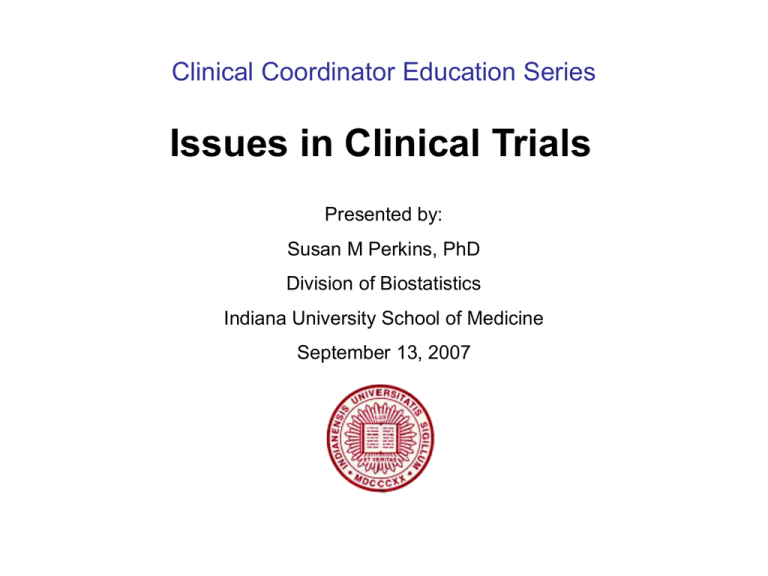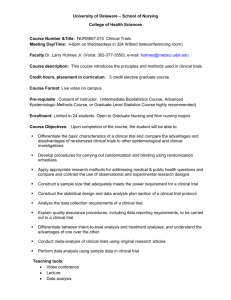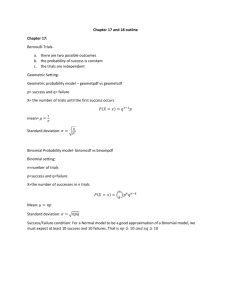Clinical Trials A short course
advertisement

Clinical Coordinator Education Series Issues in Clinical Trials Presented by: Susan M Perkins, PhD Division of Biostatistics Indiana University School of Medicine September 13, 2007 “The best time to contemplate the quality of evidence from a clinical trial is before it begins. Conceptualizing and designing good clinical trials is never an accident but results from careful planning.” Steven Piantadosi in Clinical Trials; a Methodologic Perspective Outline • • • • • • • • Definition Ethics Design Randomization and Stratification Sample Size and Power Analysis Useful Web Resources Bibliography Definition • • Word “clinical” is derived from the Greek kline which means bed so the term seems to be related to the “bedside” aspect of the patient/physician relationship. A clinical trial is a type of research study that tests how well new medical approaches work in people. These studies test new methods of screening, prevention, diagnosis, or treatment of a disease. Types of clinical trials • • • • Phase I: Primarily dose-finding trials. – Primary concern: safety. – A great deal of the pharmacology and biological effects in vivo is learned in these trials. Phase II: Primarily feasibility and estimating treatment efficacy trials. – A fixed dose of a drug is used on a small number of patients. – A balance between efficacy and feasibility (side effects & toxicity) is considered for a large-scale study. Phase III: Large comparative efficacy clinical trials. – A new treatment vs. standard or placebo (if no standard therapy exists). – Such trials will favorable to the new treatment only when they demonstrate large benefits that can not be explained by chance alone. Phase IV: Post-marketing observational studies. – Attempts to “catch” rare adverse reactions to the medication or procedure. Ethics • Autonomy (right of patients for self-governance) To exercise this right, a patient must be informed on the benefits and potential risks of the new treatment/procedure (related to the requirement of obtaining informed consent from patients). • Beneficence is the patient’s right to be benefited from therapy, and the physician’s duty not to harm the patient. • Justice or fairness of distribution of the burdens and benefits of the research. For example, testing on poor people or minorities, and then distributing to the privileged would be in direct violation of this principle. Design of clinical trials • • • • Proper design and analysis allows the investigator to attribute observed differences reliably either to the factors under control or to random error. Easier to control many sources of variation through design for the laboratory or industrial based experiments, but not for the clinical trials. This is one of the reasons that requires clinical trials relatively larger number of subjects to provide control over random variation. Skillful analyses can almost never correct design faults. For example, study selection bias. Features of well-designed clinical trials • • • • • Clearly stated objectives. Well-defined endpoints or quantifiable measures derived from these objectives. A priori stated decision rules for success or failure of the experimental treatment based on statistical tests involving these endpoints. When necessary, a clearly presented calculation of the sample size and its associated power. Well-described patient inclusion and exclusion criteria, and patient screening and randomization. Features of well-designed clinical trials • A system of data monitoring; this includes: – Safety and efficacy monitoring, possibly by an external body (e.g., a Data Safety Monitoring Board or DSMB), with possibly explicit rules for early study termination. – Data quality monitoring and error correction. • All examinations, tests, and evaluations described in detail along with a schedule of when they are to be performed. • A data collection system which is based on data collection instruments called Case Report Forms (CRFs) as well as a system of digital data entry. Some common designs Dose Finding Study – (Phase I): • A commonly used method is ● Assign a group of 3 subjects to the first dose level (1 by 1). ● Follow the following rule for dose selection. --- no toxicity escalate the dose by one level --- two toxicities terminate and declare the previous level the maximum tolerated dose (MTD) --- one toxicity add 3 more subjects and ►stops trial and declare previous dose the MTD if there are ≥ 2/6 toxicities ►escalate the dose by one level if 1/6 experiences toxicity and continue the trial. Some common designs • Two-stage design (Phase II): – Do one interim analysis where the study is stopped if there are not enough responders. – Example: New drug in ovarian cancer. • Optimal two-stage design to test the null hypothesis that the response rate is P<=0.05 versus the alternative that P>=0.25. • After testing the drug on 9 patients in the first stage, the trial will be terminated if 0 respond. If the trial goes on to the second stage, a total of 17 patients will be studied. If the total number responding is less than or equal to 2, the regimen is rejected. Some common designs Comparative Study (Phase III): ● Two groups parallel study Randomly assign patients to one of the two treatment groups Patients and/or physicians can be blinded ● Cross-over trials (for example, 2 treatment with 2 periods) Suppose A and B are two treatments Assign the treatment sequence AB to the randomly selected half of the patients Assign the treatment sequence BA to the other half Use a certain washout period in between the two treatments Some common designs Comparative Study (Phase III): ● Factorial designs (for example a 2 X 2 design) Consider a study for blood pressure control with two treatments: amiloride and spirinolactone Amiloride Spirinolactone Yes No Total Yes a b a+b No c d c+d a+c b+d N Total Can test if there in an interaction effect between the two drugs. Monitoring a clinical trial Continuous monitoring of a clinical trial is required, as there are several reasons that a clinical trial may stopped before completion. • Based on the opinion of experts. • Poor accrual. • Practical reasons making completion of the trial impossible. • Evidence from another study or discovery. • Obsolescence of the trial objective. • • Unexpected adverse events that minimize any other benefits that may be procured by the trial. Based on statistical tests, because of compelling evidence of efficacy or compelling evidence of non-efficacy. Technical challenges in clinical trial monitoring ● The most significant problem when undertaking repeated analyses of study data is that the Type I error is adversely affected. ● Type I error rate is greatly inflated when several interim analyses are performed. ● If more than one analyses are carried out at the pre-specified α level (say 5%), the overall (Type I) error rate will be higher than α. ● In the extreme, if the study is analyzed a very large number of times, the probability that one of the analyses will produce a significant result (even if there is no difference between the treatments) is virtually 100%! Group sequential designs Group sequential procedures “allocate” the total alpha (Type I error) level so that the overall chance of a false positive (i.e., a significant result where none is warranted) is still . In its simplest form, there are R-1 interim analyses and 1 final analysis, producing each time a test statistic Z1, Z2, , ZR and at each point a concomitant boundary value B1, B2, , BR. The trial will be stopped if Zi > Bi for 1< I <R. Example: O’Brien-Fleming design Boundaries of an O’Brien-Fleming sequential design involving 4 interim and a final analysis. Adaptive designs • Adaptive designs allow modification to an aspect of a clinical trial after its initiation while maintaining the validity and integrity of the trial. • Examples: – Stopping due to efficacy or futility – Adaptive randomization • Covariate-based • Response-based – Sample size re-estimation – Dropping inferior treatment groups Example: Adaptive design • Goal: choose between three drug regimens for a particular type of Acute Myeloid Leukemia. • Response-based adaptive randomization used. • Randomization probabilities started at 1/3,1/3,1/3 and were adjusted after each patient outcome was observed. • As the trial progressed, two of the arms were dropped. Giles, Hagop, Cortes, et al. Adaptive Randomization study of Idarubicin and Cytarabine verses Troxacitabine and Cytarabine versus Troxacitabine and Idarubicin . . . J Clin Oncology 2003;21(9):1722-1727. Bayesian design • Bayesian designs use available patientoutcome information, including biomarker and historical information, to possibly modify the design of a clinical trial. • Potentially allow for smaller, more informative trials and for patients to receive better treatment. Example: Bayesian design • Goal was to find MTD of PNU-214936 (PNU) in non-small-cell lung cancer (Phase I trial). • PNU action is moderated by anti-staphylococcal enterotoxin A (SEA) concentration. • Each patient treated with individualized dose of PNU based on pre-treatment anti-SEA anti-body concentrations. • Modeled the probability of a dose limiting toxicity as a function of dose and anti-SEA levels. Cheng, Babb, Langer, et al. Individualized Patient Dosing in Phase I Clinical Trials: The Role of Escalation with Overdose Control in PNU214936. Journal of Clinical Oncology 22:602-609. Randomization and Stratification Randomization is used to • Control the variability of clinical outcome. • • Combat treatment selection bias (where a certain “type” of patient maybe more likely to be selected for one treatment versus the other). Create homogeneous risk strata. Stratification is used to • Balance known risk factors between the treatments under comparison. Randomization schemes ● The simplest way to randomize patients in two treatments is by “flipping a coin” (the first treatment takes the “heads” and the second treatment the “tails”). ● However, there is no guarantee of equal number of subjects assigned to the two treatments. ● For example, for N=100, the probability of equal treatment allocation is about 8% only. Randomization using permuted blocks ● To improve balance between treatment assignments we can use permuted blocks. ● Within each block, the two treatments are balanced, and the order of treatment allocation is changed (permuted) from block to block. At the end of each block both treatments are balanced. Permutation number Within-block assignment 1 2 3 4 5 6 1 A A A B B B 2 A B B B A A 3 B A B A B A 4 B B A A A B Stratification by important prognostic factors ● Every prognostic factor or prognostic factor combination (in the case of multiple prognostic factors) is made into a separate stratum. ● Treatment assignment is then balanced in each stratum yielding balanced representation of each stratum in each treatment. ● Then the blocks shown in the previous table, can be allocated at random into each stratum (thus balancing treatment allocation into each stratum). For example, Treatment assignment w/ a block size of 6 Stratum 1 2 3 4 5 6 Old male A A A B B B Young male A B B B A A Old female B A B A B A Young female B B A A A B Determination of the sample size Determining the size of the patient sample is a crucial proposition. On the one hand, ethics dictate that no more subjects than necessary must be submitted to the experimental treatment. On the other hand, a sufficient number of subjects must be experimented upon so that the question of interest is unequivocally answered. Sample Size and Power • • Power : Probability of rejecting H0 (no difference between two treatments) when HA (treatments are different) is true. Example : “Using an alpha of 0.05 and a two sample t-test, a sample size of 21 in each of olanzapine and placebo groups will have 80% power to detect a minimum difference of 80 calories in the change in basal metabolic rate (BMR).” Interpretation : Suppose the minimum difference in the change in BMR between the olanzapine and placebo group is 80 cal. If we repeat a study a large number of times with 21 subjects in each group, at least 80% of the times we will reject the null hypothesis that there is no difference between the placebo and olanzapine groups. Analysis • ICH E9 guidance – Clinical studies should be carried out according to International Conference on Harmonisation (ICH) / WHO Good Clinical Practice standards. – Focus is on statistical principles. – E1, E3, E4, E5, E10, and E11 also have statistical content. Data analysis and presentation of results Types of Data • Qualitative response – “Success”/”Failure” – Remission/relapse • Quantitative response – Blood pressure – HIV RNA concentration – Percent change of neuropathic pain • Time to Event data – Time to relapse or death – Time to development of toxicity Steps in data analysis and presentation of results After completion of part or all of the study, the following preparatory steps must be followed: • Data cleaning. • Descriptive analyses. • Statistical Inference. • Reporting and presenting the results. Statistical analyses Descriptive analyses • Qualitative data – Frequency tables – Frequency histograms • Quantitative data – Descriptive statistical tables – Histograms (preferably with error bars) – Line graphs (especially if longitudinal trials) • Time to Event data – Frequency tables (number of subjects that failed) – Kaplan-Meier (KM) plots Statistical analyses Inference • Qualitative data – Tests on proportions (binomial, normal) – Chi-square or Mantel-Haenszel test – Logistic regression and Generalized Linear Models (GLM) • Quantitative data – T-tests, analyses of variance (ANOVA) and covariance, GLM – Non-linear models (particularly in pharmacokinetic studies) • Time to Event data – Log-rank test (nonparametric) – Cox Proportional Hazards (semiparametric), accelerated failure-time (AFT) models – Parametric models (e.g., Weibull, Gompertz, exponential) Common Assumptions • Qualitative data – Need large enough sample sizes at each level of the variable of interest • Quantitative data – distribution of response or residuals from modeling procedure (usually assume normality or log-normality) – Equal variances in response across groups (in ANOVA) • Time to Event data – Censoring independent of follow-up time – Proportional hazards (for Proportional Hazards model) – Specific time distribution (e.g., Weibull, Gompertz, exponential) for parametric models Concerns for Multi-center Studies • Main purposes are to accrue patients in reasonable amount of time and increase generalizability. • Statistical issues – Delays in submitting data for monitoring – Pooling the data across centers – Treating center effect as fixed vs. random – Heterogeneous treatment effect across centers (interaction) Confounding Variables and Covariates • Covariate – variable related to the outcome. – Confounder – variable related to both the outcome and the treatment – Effect modifier – variable that affects the relationship between the treatment and the response Confounding Variables and Covariates Dealing with confounding: – Prevention • Restriction • Matching • Randomization – Control through analysis • Stratification • Regression Multiplicity Adjustments Suppose we have three groups: A, B, C Could do multiple two group tests: A vs. B B vs. C A vs. C ....... BUT: If = 0.05 for each test, then the overall level is = 0.14 for three tests. When there are no true differences, one would expect to erroneously decide that there is at least one difference 14% of the time. Multiplicity Adjustments • Use multiplicity adjustment techniques to make multiple comparisons among pairs (all or some subset) of group means. • Well-known tests: – – – – – Bonferroni correction Scheffe Student-Neuman-Keuls Tukey’s HSD Duncan Multiple Range Useful Web Resources • http://firstclinical.com/glossary/ • http://www.ich.org/cache/compo/475-2721.html Bibliography • Berry, D. (2006) Bayesian Clinical Trials. Nature Reviews 5:27-36. • O’Brien, PC, and Fleming, TR (1979) A multiple testing procedure for clinical trials. Biometrics 35:549-556. • Piantadosi S. (1997) Clinical Trials. A Methodologic Perspective. John Wiley and Sons, Inc. New York, NY






